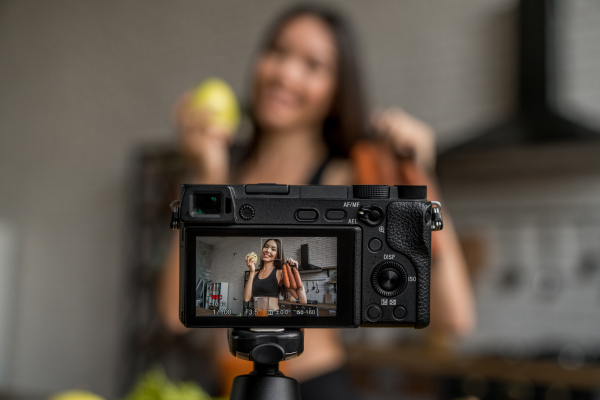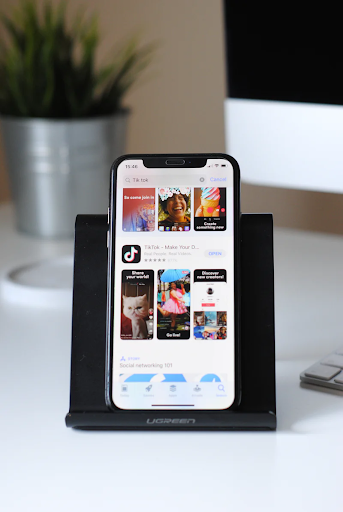Influencer Partnerships: Are They Right For Your Brand?

Remember a time when Instagram influencers were limited to celebrities? We do, because Instagram feeds were much simpler back then. However, these days, your feed may be flooded with influencer posts – but are influencer collaborations still as effective as they once were? The answer is “yes,” as long as expectations, terms and messaging are altered to fit current times.
If you’re a social media marketer, you know what we’re talking about. Your clients want to work with influencers. It sounds like a good idea, so you do it. But then you see there wasn’t an ROI in paying an influencer to promote your client’s products or services. You did everything the client wanted, but you also know that the tactics could be tailored to really connect with an audience.
The thing is: There is a strategy to influencer marketing. It’s more than just asking them to create pretty photos with your product. And this strategy requires work from the brand (that’s you).
In this blog post, we discuss the right way to launch an influencer marketing campaign, and how to determine if an influencer campaign is right for your brand.
How Did Influencer Marketing Come to Be?
Influencer marketing, at its core, is not a new concept. Celebrities have been getting paid for endorsements for a long time now. Influencer marketing is essentially the same thing as celebrity endorsements, but the endorsements happen on social media, and instead of limiting the influential platform to famous celebrities, social media personalities with established, large followings are included as well. Influencer marketing has seen success because users choose who they want to follow, and usually, they follow people they deem trustworthy and credible.

Is Influencer Marketing Right for You?
In our experience, influencer marketing’s return on spend is very similar to digital advertising, with the added bonus of gaining social media followers, social media engagement, brand awareness and word-of-mouth credibility. However, it all comes down to your goal. Is it brand awareness? Followers? Or is it sales? All these things must be considered prior to choosing an influencer to work with.
For instance, let’s say you have an influencer you’d like to partner with, and your main goal is to increase sales. This influencer charges $1,000 for a static post, and has proven results with similar brands at 3 sales per post. However, your product costs $30 a piece. In this case, partnering with this influencer is not the best option for you, since you will more than likely lose money instead of receiving an ROI.

How JEMSU Manages Social Media Influencer Marketing
JEMSU will first determine whether your marketing budget is best spent on collaborating with influencers. Then, our social media team will tap into a curated network of influencers — ones we have built relationships with — to choose the best ones to partner with and deliver you successful results.
Then, JEMSU will create talking points, provide direction and even create a detailed contractual agreement between your brand and the vendor to ensure you receive high quality service and media quality. Upon completion of the collaboration, JEMSU will track results and provide a report.
If all of this sounds nice to you, but you’d rather manage influencers yourself, no problem. We break down how to go about that below.
Social Media Influencers in 2020
In 2020, the influencer market is pretty saturated, and it’s much harder for new users to gain a big following quickly. There was a time when it was fairly easy to get featured on Instagram’s “explore” page, or when hashtags really drove engagement – a time when simply having an aesthetically pleasing page was one of the few things you needed to become an influencer. And after just a couple of brand partnerships, being an influencer could be a full time job, and often, a full time job that pays well.
At its peak, influential marketing involved professional cameras and highly stylized photo shoots. But trends change; marketing changes. In a profession where the goal is to stand out, social media influencers do the opposite: many have the same aesthetic, and therefore, blend in.
These days, consumers are not buying into the “staged” lifestyle.
Earlier this year, The Atlantic’s Taylor Lorenz published an article, The Instagram Aesthetic is Over, which highlights social media users’ (especially Gen Z’s) need for real, relatable content. This means posting no-makeup selfies, blemishes and all. Or posting unedited photos without presets. If you’re a marketer, you’ve seen this article passed around on social media, and chances are, you’ve praised it.
While this need for a shift in the Instagram aesthetic (or lack thereof) seems to be trending for all demographics, it is especially true for Gen Z.
Take TikTok for example, a platform where sponsorships and advertisements receive a lot of backlash from the platform’s biggest demographic, Gen Z. This doesn’t necessarily mean your brand should not work with influencers if your target market is Gen Z. However, it does mean that you’d want your partnership to be authentic and raw.

How to Work with Social Media Influencers
As mentioned above, it takes more than just finding an influencer with an impressive number of followers to launch an influencer campaign. Here are action items that need to be taken first.
1. Find an influencer that’s right for you.
It’s important to first narrow down your target market. For instance, if your goal is to attract men over the age of 60, finding an Instagram influencer with that audience data is going to be difficult. However, if your target is millennial women, then Instagram may be the perfect avenue for you.
Once you know your target audience, consider your budget and product cost to determine the size of the influencer you want to work with. Micro-influencers (under 10k followers) are much more accessible, but have a smaller audience and therefore could result in less conversions for your brand. Bigger influencers can get you more followers and sales, however this comes at a high cost.
Remember, it’s not always about followers. Engagement rate should be priority. If the Instagrammer has a large following but the followers are not engaging with posts, that’s a red flag. Alternatively, a micro influencer with a highly engaged audience makes them a great partner.
This step also takes a lot of trial and error, so you may not have all the right answers until after you work with a couple of influencers.
2. The details of your influencer partnership
Once you have the big picture figured out, it’s time to iron out the details. This includes compensation, services, terms, landing page, promo code (if applicable), messaging and more.
Compensation and services can be determined by either the influencer or yourself, depending on your pitch (more on that in the next point). Terms can be negotiable, but it’s common for the brand to come up with those expectations and talking points. Landing pages or promo codes should always be provided by the brand. As for messaging, it is important to give the influencer creative freedom, but this doesn’t mean you can’t provide guidelines or talking points. Make sure your influencer is knowledgeable on what makes your product better than the competition, this could make or break the success of the collaboration.
3. How to reach out to influencers
Research, research, research. This part is tedious, and to be honest, kind of a drag. For micro influencers, you could reach out directly in a comment or private message. For influencers with bigger followings, you may have to go through their management. Make sure to create an excel spreadsheet detailing each influencer, their follower count, engagement rate, whether you’ve contacted them, whether they’ve responded, and their rate. JEMSU has done this so many times, that we luckily now have networks of influencers for many industries. Our social media team regularly updates each sheet as they come across influencers. However, if your industry or demographic is new to us, we sometimes have to start with Step 1: research.
Earlier in this blog post, we talked about important (perhaps obvious) things to be mindful of, such as followers, engagement rate, target audience, etc. So here are some additional, not-so-obvious- things we learned from experience. That’s right, we’re giving you this information for free.
- What is the influencer’s sponsored v. organic content ratio? One time, we worked with an influencer whose profile looked great. However, upon signing an agreement with us, she began posting ONLY sponsored content… and this went on for weeks. She even promoted a direct competitors’ product, which brings us to our next point.
- Exclusivity. Make sure to include somewhere in the content that you’d like exclusivity for a time period that is fair both to your brand and the vendor.
- Can they show results from previous campaigns? Their follower count and engagement rate can be great, but if their sponsored content doesn’t get results, then they may not be the best option for you.
- Do you want them to post during prime time only? Be sure to mention you’d like to exclude specific days and times if that is a preference for you. Your sponsored post will probably not receive the same results on the morning of Fourth of July like it would on a weeknight in October. At JEMSU, we keep this in mind when outlining the influencer’s post schedule.
- Do you want the influencer to run ads for your brand? Sometimes, sponsored posts from influencer pages see much higher Return On Ad Spend (ROAS) than a company page’s ad. This is due to the fact that consumers trust humans more than they do companies, so your ad dollars may be better spent on the influencer’s profile.
- Consider a giveaway, especially if your main goal is followers. By partnering with an influencer and tapping into their audience, you could potentially gain a lot more followers. Not to mention, they will follow you because they’re genuinely interested in your product, which means they are likely to be engaged, and maybe even become buyers.
4. Analyze and optimize
If you’re new to influencer partnerships, chances are you’re not going to see perfect results the first time around. So be sure to track everything, ask your vendor to provide all insights, then refine and try again. Here’s how.
Measuring the Success of an Influencer Partnership.
First, you can’t possibly track results without initially outlining your goals. Make a note of your goals in order of priority. Your primary goal may be sales, while your secondary goal could be followers and tertiary goal is brand awareness. In this case, it’s best to track your primary goal via UTM tags or a promo code unique to your influencer. The secondary goal would require a benchmark of numbers and tracking any spikes on the day of (or after) the influencer’s branded posts. Our tools like Sprout Social provide that information to us. Your tertiary goal, engagement, can be measured via a hashtag, and any increase in its mention. This is also something we can track via our paid subscription-based tools.

Working with a Marketing Agency for Influencer Partnerships
Our social media team has a more than decade of social media experience with more than 5 years of influencer marketing experience. We have built relationships with influencers of all sizes, and can contact many via a single email. Additionally, we provide detailed reporting and strategic counsel to help you make the right decision within your budget. Let us help you.
Do I Need to Work with Social Media Influencers
Maybe, maybe not. We have talked as many clients out of working with influencers as we have into it.
Truth is, while consumers are demanding a more authentic, real social media feed, influencers are here to stay. It’s the way the messaging is presented that is important, and how to find the right influencer for your brand. This is where our expertise comes in.
The world of social media influencing has changed, and the way it operates should as well. Professional marketers have the skills and knowledge to help your brand create effective partnerships.

We understand that hiring a marketing agency like JEMSU may not be in your budget, which is why we put together guides like this one. You may also contact us for any additional questions.
Our best advice: If it doesn’t work the first time, don’t give up. No two influencer partnerships are equal, and it takes time to find the right one.
Are you a marketer? If so, what campaigns have worked for your industry? Any tactics or important points we missed? Let us know in the comments!